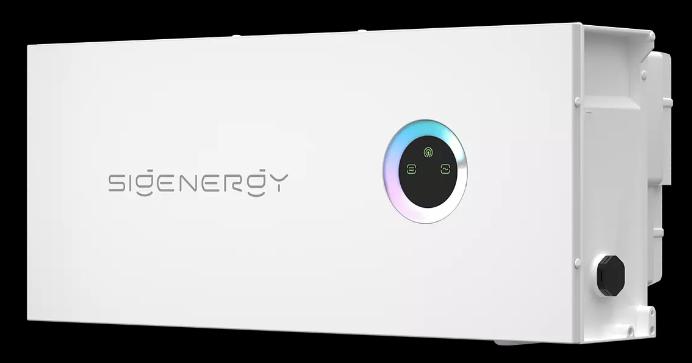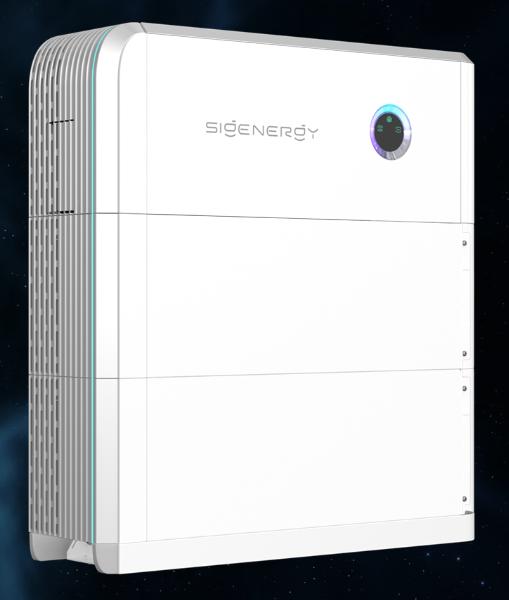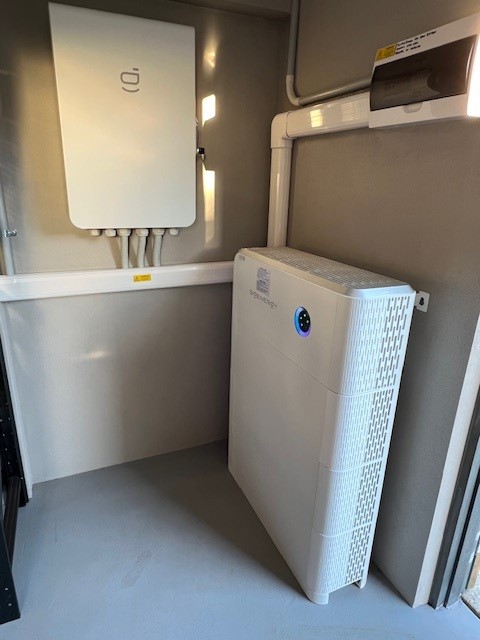Sigenergy SigenStor inverter and battery review - Updated October 1st 2025
Sigenergy DC EV Charger 40% price drop ! (08) 9467 9655
Sigenergy are the only inverter/battery brand with a bi-directional DC EV charger.
That means you can not only fast charge your EV purely from solar and battery,
but you can also use the battery in your EV to power you home (it's called V2H)
YouTube video about this charger here.
Maybe sales were a bit sluggish at $8,000, because now it's $5,000 for the 25kW model.
The 12kW model is a bit over $4,000.
That's getting down to what a regular AC EV charger costs including installation.
It comes with a 10m cable and installation is simply putting it on top of the battery stack.
No cables back to the switchboard, no breakers. Brilliant.
The only wrinkle is that your EV must be within 10 metres of the inverter and battery stack.
Sigenergy inverters and batteries.
All the inverters, from 5kW to 30kW are the same size.
The 5kWh and 8kWh batteries are the same size as well.
The batteries can be mix and matched as each works independently of each other.
It's a clever, future-proof design.
Want a larger inverter down the track?...no problem it just swaps out.
Sigenergy release a larger capacity battery?...no problem just add it to the stack.
Reliability
We have installed gazillions of these and had one faulty battery so far.
As each battery in the stack is a law unto itself, the rest carried on working.
It's a top quality product and the warranty service from Sigenergy was fast.
Backup Gateway
The primary purpose of this box is to provide power during a blackout.
We almost always install these next to the switchboard.
The entire house supply runs through the box.
When the grid fails it instantly islands itself from the grid and provides solar and battery power.
I've tested it many times by turning off the house main switch and haven't seen so much as a light flicker.
The Gateway also has CTs clamped around the incoming cable so you don't need a separate energy (consumption/smart) meter.
The CTs measure the house loads and let the inverter know when to store or release battery power.
If you don't buy the Gateway, then you simply install an energy meter in the switchboard instead to do the same job.
The Gateway has non-backup ports.
If you don't want your AC, Oven or other non essential high draw loads backed up then they can be split off.
This involves disconnecting the circuit from the house main switch and running a cable from the breaker to the non back-up port.
Therefore, it adds cost to do it.
The Gateway can connect other energy inputs.
That might be another solar inverter or a generator.
You can also use the 'smart port' in the Gateway to connect a load you want to control.
Maybe a hot water system. You can turn the load on and off via the app, set schedules and more.
Again..it's more cabling, more time, so it's done at a cost.
Sigenergy AC EV chargers.
I have described the DC EV charger above, but Sigenergy also have smart AC EV chargers.
Both the inverter and EV charger are connected by Wi-Fi or Ethernet to your home router/modem.
The EV charger can be set to only charge from available solar (and battery if you want).
AI assistance
There is AI help in the app for both installers and users.
There is also an AI operational mode so the system learns your usage patterns.
It can reference weather forecasts, grid buy and sell pricing and adapt it's charge/discharge accordingly.
In Western Australia we don't have any call for that yet seeing as we don't have any energy competition.
Tigo optimiser integration.
It's very rare these days for us to install any optimisers.
Modern panels cope with shade very well on their own.
However, when people want optimisers, we use the Tigo brand.
They have their own reporting system as an option.
That reporting system can be integrated into the Sigenergy reporting system.
Sigenergy inverter range
5kW, 6kW, 8kW, 10kW and 12kW single phase inverters.
The 5kW and 6kW have 2 x MPPTs, the 8kW has three, and the 10kW and 12kW have 4 MPPTs.
5kW, 10kW, 15kW, 20kW, 25kW and 30kW three phase inverters.
The 5kW has 2 x MPPTs, the 10kW and 15kW have 3 x MPPTs, the others have 4.
Sigenergy battery range.
5kWh and 8kWh currently with a 6kWh and 10kWh model possibly down the track.
The rest of the World has already got the 6kWh and 10kWh but Australia won't have them for a while.
The reason for the delay here is entirely down to the daft approval process of the Clean Energy Council.
It's a long story.
The 5kWh has 5.1kWh usable energy, the 8kWh has 7.8kWh usable, and the 10kWh has 9kWh usable.
(I don't agree with them calling it a 10kWh battery when only 9kWh is available. Call it a 9 !!)
Oversizing Sigenergy inverters with more panels
200% oversizing is the sweet spot in my opinion.
A 5kW inverter with 10kW of panels, a 10kW with 20kW of panels for example.
Oversizing beyond that 200% mark is allowed but usually pointless.
You can only oversize beyond 133% when you connect a battery.
All the Sigenergy inverters (now) can be installed without a battery.
They are wall mounted without a battery.
Sigenergy pricing.
It's quite expensive compared to the budget brands...
...Growatt, Alpha, SAJ, Anker, Fox, Dyness, Goodwe.
All of those (and many more) will come in quite a bit cheaper.
In most cases, for good reason.
The build-quality on much of the budget gear is really pretty flimsy.
A pretty plastic decorative cover can conceal a lot of things.
There's also far too many of them competing in our very small, already saturated market.
Almost certain that many/most will be long gone before their 10 year warranties are up.
That's what happened with budget solar inverters in the early days, where only a couple survived.
Compared to other much better quality brands like iStore, Sungrow, and Fronius, Sigenergy are very competitive.
All the batteries out there have lithium iron phosphate (LFP) cells inside.
Even the budget brands.
It's a safe and suitable chemistry for storage in a residential environment.
Do they all have fire-fighting equipment inside each battery? Of course not.
That costs money. Sigenergy does.
Sigenergy support.
It's an unusual system but mostly, it is pretty good.
They have trained some of their wholesalers so when we need a question answered we can ask the wholesaler.
For on-site help for our install team there's a number to call which usually gets answered quickly.
The AI is also helpful for fault-finding.
The main source of support though is our own experience with it.
For end users, Sigenergy operate a Facebook page.
It seems to address many questions.
Warranties
Inverters and batteries 10 years.
Backup Gateway 5 years (with an option to extend to 10 years
Energy meters 2 years.
DC and AC EV chargers, 3 years.
Datasheets
Inverters
Batteries
Backup Gateways
DC EV Chargers
AC EV Chargers
Sigenergy corporate brochure
Sigenergy 1ph/3ph consumption / smart meters (included in backup box)
MySigen app
You'll find the Sigenergy MySigen app in the usual stores.
There's also a web page portal, https://app-aus.sigencloud.com/
It's my favourite type of solar reporting app.
Very simple on the face of it which will suit most people, but plenty hidden away for those who like deep-diving.
VPP (Virtual Power Plant) ready? Yes
So who are Sigenergy?
Yes, Chinese, and the founder and CEO is ex-Huawei and Ascend AI, one of the largest AI companies in the World.
Reportedly he started up Huawei's solar division in 2011 and drove it to becoming World No 1 before leaving in 2020.
There's a lot of 'Huawei-like' things I recognise in the Sigenergy products.
Battery optimisers, fire extinguishers, even the identical AC plug and very similar appearance.
It seems that Tony Xu and his Sigenergy team have taken things a lot further than Huawei have done.
It's not hard to search YouTube for plenty of Sigenergy videos. Makes for interesting viewing.
Sigenergy have already had a lot of success and some very interesting installations in Europe.
If you are interested in some really large solar installs; Commercial, Industrial then Sigenergy scales up.
Inverters are paralleled together, as are stacks of batteries. On-grid or Off-grid.
Here's a quick video of a recent off-grid Australian install with 70kW of inverters and over 336kWh of battery storage.
That's 7 stacks of 6 x 8kWh Sigenergy batteries, with backup and a big generator connected on standby.
Sigenergy inverter (which can be wall mounted on it's own without batteries).

Inverter with 2 batteries. Can't say what size inverter or batteries as they all look the same.

A real life installation picture...

Home Assistant integration with Sigenergy.
Click this link for Github instructions and downloads.
Sigenergy in the USA
It is branded as Pointguard.
Sigenergy Australia support number.
0452 417 654. A mobile number that goes to voicemail.
Leave a brief message and Sigenergy support will usually call you back within an hour.
or email
This review was written by Andrew MacKeith, Solar4Ever service manager since 2011.
Solar4Ever is located in Morley (Perth), WA 6062
